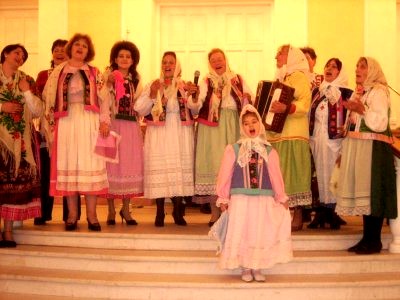New Book: Land of Dukhoboriya
Книга «Страна Духобория»
About Doukhobors, by a Russian Doukhobor: Alla Nik. Bezhentseva В
Посольстве Российской Федерации в Грузии состоялась презентация книги
«Страна
Духобория» Аллы Беженцевой, выпущенной
«Русским клубом» в 2007 году.
В
Посольстве Российской Федерации в Грузии состоялась презентация книги
«Страна
Духобория» Аллы Беженцевой, выпущенной
«Русским клубом» в 2007 году. A new book, Land of Dukhoboriya (cover, right), about Doukhobors written by a Doukhobor was published in 2007 in the Republic of Georgia where the author, Alla Nikolaevna Bezhentseva, was raised and lives. The photo above shows her at the December 2007 book launch ceremony held in the in the Embassy of the Russian Federation in Georgia, Tblisi. The book was sponsored and published by "The Russian Club" of Georgia. A choir of Doukhboors (below) from her village of Dmanisi sang.

Dmanisi Doukhobor choir at the Russian Embassy in Georgia celebrating the release of Strana Dukhoboriya. 10 photos appear on the Russian Club website.
Bezhentseva was born in Tbilisi, has PhD in science, is an accomplished writer, and a recognized advocate for human rights. The Russian Government supported the launch of her book, and helped many Doukhobors migrate from the Caucasus back to central Russia.
Click to enlarge cover:

The 152 page book is available free for download as a PDF file in Russian.
The title in Russian: Strana Dukhoboriya, can be translated:
- Land of Dukhoboriya,
- Land of the Doukhobors, or
- Doukhobor Country
Also see: New Russian Book Chronicles the Doukhobors, Press Release, December 31, 2007, by Jonathan Kalmakoff.. An English translation of select chapters will appear on his Doukhobor Genealogy Website in early 2008.
Book Review:Alla Bezhentseva. Strana Dukhoboriya [Land of the Doukhobors](Tbilisi, Republic of Georgia: International Cultural-Educational Union ‘Russian Club’), 2007. Russian language. 152 pp. By Koozma J. Tarasoff. February 7, 2008. All rights reserved. |
|
| In the past
100
years most books and articles about Doukhobors were produced in North
America, mostly in Canada, by local Doukhobors, scholars and
journalists. Up to now, only one book about Doukhobors was written and published in Europe by a Doukhobor — Gregory Verigin, Ne v Sile Bog a v Pravde [God is Not in Might, But in Truth]. Paris, 1935). I know of no other book written in Europe by a Russian Doukhobor about Doukhobors, until now. Strana Dukhoboriya [Land of the Doukhobors], is the first book about Doukhobors by a Russian Doukhobor. Written by Alla Bezhentseva, it was published last year in the Republic of Georgia (part of the Former Soviet Union). I was excited to download a free copy from the Internet and read it. I was eager to find new facts and perspectives of our history unknown to us in the West, who live far from our roots.  The
author Alla
Nikolaevna Bezhentseva (born in Tbilisi in 1953 with Doukhobor
roots) is a renaissance woman. Besides being an accomplished
structural engineer educated in Moscow, she advocates for human rights
as a leader in many civic organizations. She has been honored with
several awards including the 'Order of Character' (Georgia), and 'State
Prize Laureate of the USSR'. The
author Alla
Nikolaevna Bezhentseva (born in Tbilisi in 1953 with Doukhobor
roots) is a renaissance woman. Besides being an accomplished
structural engineer educated in Moscow, she advocates for human rights
as a leader in many civic organizations. She has been honored with
several awards including the 'Order of Character' (Georgia), and 'State
Prize Laureate of the USSR'.  She
is President of the Union of Russian Women of Georgia ‘Yaroslavna’;
Director of the legal center 'ETNO', which provides legal, medical and
educational assistance to national minorities; Secretary General of the
organization 'Multinational Women of Georgia'; a delegate at the 2006
World Congress of Compatriots held in Moscow; and Vice-President of the
International
Cultural- Educational Union of Georgia called ‘Russian Club’ [Russkii Klub] which launched this
book.
Since 2005 she has
been the Head Editor of Russkii Klub. She
is President of the Union of Russian Women of Georgia ‘Yaroslavna’;
Director of the legal center 'ETNO', which provides legal, medical and
educational assistance to national minorities; Secretary General of the
organization 'Multinational Women of Georgia'; a delegate at the 2006
World Congress of Compatriots held in Moscow; and Vice-President of the
International
Cultural- Educational Union of Georgia called ‘Russian Club’ [Russkii Klub] which launched this
book.
Since 2005 she has
been the Head Editor of Russkii Klub.
 Her
previous books were Moi rodnoi yazyk [My Native Language] in Russian;
and Zhenschiny
Gruzii: konfessial'nyi i polietnicheckii aspekt [Women of
Georgia: The Religious and Multi-Ethnic Aspect] 2006, with a section on
Doukhobor women. Zhenschiny
Gruzii is a book and film, with 1000 copies
distributed in two languages, Russian and Georgian, 'to overcome
exclusiveness, alienation and avert the discrimination, caused by
various forms of intolerance.' Minority women in Georgia typically have
no access to the Internet, nor radio in their languages. Her
previous books were Moi rodnoi yazyk [My Native Language] in Russian;
and Zhenschiny
Gruzii: konfessial'nyi i polietnicheckii aspekt [Women of
Georgia: The Religious and Multi-Ethnic Aspect] 2006, with a section on
Doukhobor women. Zhenschiny
Gruzii is a book and film, with 1000 copies
distributed in two languages, Russian and Georgian, 'to overcome
exclusiveness, alienation and avert the discrimination, caused by
various forms of intolerance.' Minority women in Georgia typically have
no access to the Internet, nor radio in their languages.The Contents of Strana Dukhoboriya include the historical development of religious sects and movements, Doukhobors as Christian and Protestant learning, propagandists of the Doukhobors, history of the Doukhobor commune, Canada — the Second Motherland, problems of integration, and Doukhobors during the Soviet era. The Addendum follows with a useful look on traditions past and present (including local dialect, clothing, songs and psalms of the Doukhobors), farewell wishes of an elder Doukhobor women in Dmanisi, a psalm from the Doukhobor Book of Life, bibliography, and an interview with the author who says ‘I always faced hardships’. In exploring the origins of the Doukhobors, Alla acknowledges that the unified origin of the Doukhobors since the 1700s ‘remains unclear’. Suggested sources are the intelligentsia, the Masons, European Protestantism, and the propagandist G.S. Skovoroda (who said that Christ resides in people). What is clear for her is that peasants rebelled against the corrupt church which once controlled up to one million serfs and purchased sins. As a cultural reaction, the illiterate but not naïve peasants rejected icons, many stopped going to church and taking communion, while others condemned priests and popes. The common ground of the peasant revolt, writes Alla, was ‘a search for equality based on reason’. Sectarianism gradually evolved into a social movement, of which the Doukhobors are a good example. Maintaining and nurturing an organized group required special strategies of isolationism and fear (contrasting the ‘we’ from ‘they’), wearing distinctive costumes of separation, singing in a code that outsiders could not understand (such as the early Doukhobors had done with their innovative psalms), and at times being pushed to extremism and fanaticism (such as castration by the Skoptsi, burning themselves, rejecting books and state citizenship, and bowing slavishly to a spiritual leader). Early Doukhobors gathered together in sobranies and learned the wisdom of the past prophets such as Christ by word of mouth or what they called as ‘our living book’. They considered no notion of God other than that as a power of us humans in the spirit of wisdom and love. For these people, Jesus Christ was a good man — he was God and man in one. Taking this as their guide, Russian Doukhobors argued that because God exists in each of us, it is therefore wrong to kill another human being. Hence a strong ethic of love was born. Alla points out that the first settlement of the Doukhobors in the 1700s took place in the Russian gubernia of Tambov. It attracted dissidents from Kharkov, Saratov, Ekaterinoslav, Voronezh, Astrakhan, and Pensk gubernias, as well as from the Don, Siberia and Finland. They survived and adapted, writes Alla, largely because of ‘their quiet, sober and good moral life’. Because of the tortures, beatings and persecution of the Doukhobors, in 1802 Alexander I invited the Doukhobors to settle en masse in the Milky Waters area of the Crimea. Here nine villages were established containing 4,000 people. Saveli Kapustin headed the colony out of the central village of Terpenie. Kapustin was a tall figure, manly, good speaker and a brilliant mind (he knew the Bible by heart). He was well respected and was called ‘Moses’ because he relocated the dissidents from scattered areas of the empire. As a result he achieved great power over them and began thinking about creating a Doukhobor nation. At one point he contradicted his beliefs by proclaiming ‘I am Christ, your Lord. Fall on your knees.’ That was a ‘no-no’ because history teaches us that power often corrupts. Author Alla Bezhentseva then goes on to tell us in detail about the exile of the Doukhobors from the Milky Waters to three areas in the Caucasus. The most famous location was Dzhavakheti [Javakheti, Javakhk]* (which the Doukhobors called Bogdanovka) [map]. Once rich and bountiful, it was located in the large caravan road trade route which tied Georgia to the rest of the world. Over time the area became the battleground for conquerors. When the Doukhobors moved there in the 1840s to the high plateau, the mountains had practically no forest growth except evergreens and black poplars. It was very severe: cold, rocky, wheat cannot ripen due to the short season, and there was lots of snow, but not enough ground water. It was known as ‘cold land’ or ‘kholodnenskaya’. Although the Orthodox church and state saw the Doukhobors as the most ‘pernicious’ group, the Tsarist government also saw value in the Doukhobor settlement as security against the marauding Turks of the day. In spite of frequent and brutal attacks and rape by the Turks, the Doukhobors survived and prospered and in fact became richer than the Russian peasants of Central Russia. How this prosperity evolved is worthy of note for it occurred at the time of the Golden Age of the Doukhobors during the leadership of the first woman leader — populist Lukeria Kalmykova (1864-1886). Under her initiative, a Sirotskii Dom was built in Gorelovka. Besides serving as a home for orphans and the aged, it became an administrative center of the Doukhobors. With their excellent horses, the Doukhobors transported products not only around the Caucasus but also to Russia, Turkey, and India. They also had contracts for transporting mail for the government, passengers, and local flour industry and agricultural implements. They lived in a MIR or commune system and regularly redistributed land on a collective basis which helped all. For self-protection, from time to time the government issued guns to them to deal with Tatar bandits. It was therefore not surprising that in spite of the strong pacifist ethic of Lukeria and her group, the Russian Government persuaded them to help with transport during the Russian-Turkish War of 1877-1878. The Government engaged some 4,000 caravans to carry supplies such as food and guns to the field over difficult roads. Author Alla revealed that ‘150 Doukhobor drivers were killed’ while wounded Russian soldiers were regularly brought home for medical aid practically every day. As a reward, the Doukhobors benefited financially for their service (Sirotskii Dom had half a million rubles in cash) and their community received a small hospital (page 52-54) and continued contracts for mail deliveries. The population statistics of this thriving community during Lukeria’s time was as follows: Tiflis Gubernia: 7,132. Elisavetpol Gubernia: 2,277. Kars Oblast: 2,805. Also Doukhobors were found in Dagestan, Tverskoi Oblast and Yerevan Gubernia (p.56). [Map.] All seemed to be going well until the dark clouds suddenly enveloped their commune. In December 15, 1886 their leader Lukeria Kalmykova died. The death signaled a crisis in property inheritance when Michael Gubanov (Lukeria’s brother) clashed with Lukeria’s ‘secretary’ Peter V. Verigin. The Government sided with Gubanov and arrested Verigin for disturbing the peace. Verigin was eventually exiled for 15 years first to Archangelsk in the north and then to far-off Siberia. The Doukhobors divided into at least two factions: The Big Party under Peter V. Verigin and the Small Party headed by Gubanov and elder Zubkov. The struggle with inheritance of Sirotskii Dom showed how far Doukhobors had departed from earlier roots. It showed a disparity between the haves and the have-nots. It also showed that many people were not happy with the fact that Lukeria’s community had been involved in transporting goods to the Russian — Turkish front which transgressed the commandment ‘Thou shalt not kill’. Doukhobor messengers traveling to see Peter V. Verigin went through Yasnaya Polyana, met with Lev N. Tolstoy and revealed their story and their philosophy. They were warmly received by Tolstoy and Tolstoyans such as Vladimir V. Chertkov, Ivan Tregubov, Prince Khilkov and Pavel I. Biryukov, who gave them journals and books such as Tolstoy’s Kingdom of God is Within You. Tolstoyan propaganda anticipated exile to isolated areas where Doukhobors and Tolstoyans would live in peace, wrote author Alla (p.65). |
Verigin in
exile read these, secretly adopted Tolstoy’s views, and
decided a strategy that would bring attention to himself as a prophet
as well as the plight of the Caucasus Doukhobors. His ideological
program for the Doukhobors can be summarized as follows:
The kingpin of the ideology was the creation of an incident that would bring world attention to the Doukhobors and ensure help from Lev N. Tolstoy. This was the June 29, 1895 arms burning, a mass act of protest against war in which some 7000 Doukhobors participated in three areas of Georgia, Elizavetpol, and Kars. The authorities saw this as a revolt and reacted severely by sending in Cossack troops which attacked unarmed Doukhobors in the Bogdanovka plateau near the village of Orlovka. Here Cossacks ravaged all property in the villages, beat the men with whips, raped the women, and dispersed them into the mountains. With no economy there was no future. Out of 4,000 who sided with the Verigin decree, 1,000 Doukhobors died. Doukhobor young men who refused military service were exiled to Siberia for 18 years. The idea of relocating Doukhobors outside Russia began and a movement to help Doukhobors arose under the leadership of Lev Tolstoy and his followers. Newspapers reported on them. Articles and books were written about them. They became popular at the end of 1800s. Tolstoy saw the Doukhobors as an example of a people who in practice realized his ideas. His voice was heard around the world. Tolstoy and Verigin were against Doukhobors migrating abroad, but they were overruled by a Doukhobor skhodka (convention), wrote Alla (p. 78). Once the most persecuted Doukhobors decided to move, Tolstoy wrote countless letters and personal requests to the media, to rich people, to the Quakers, to immigration officials and others. To the Swedish paper he proposed that the Nobel Prize go to the Doukhobors. Eventually with the help of many, four shiploads were engaged and 7,500 Doukhobors came to Canada in 1899. Once in Canada, Alla Bezhentseva writes, the process of assimilation began. The government did not wish to see the communal enterprise survive. Instead, it pushed for a full private enterprise ethic in a capitalistic country. Conflict was anticipated and indeed took place with the loss of land in Saskatchewan in1907 and the movement with Peter V. Verigin of two-thirds of the Canadian Doukhobors to British Columbia. With the advent of Tolstoyan and anarchistic ideas pressing on the group some individuals began to act out with nude protests, nonpayment of taxes, noncompliance with Census, while a few zealots strongly discredited the Doukhobors by burnings and bombings of their own and public buildings in Canada. Still others saw an opportunity of taking out citizenship and land — and they became Independents who followed their instincts and severed ties with their leader but not with their traditional values. In this more unfamiliar ground, Alla makes some errors. First she fails to adequately distinguish between Doukhobors and zealots — a trap that many writers fall into. The actual number of acres purchased in British Columbia in 1908 to 1916 was 19,000 (not 67,000). Maria Strelioff, who was killed on the train with Peter V. Verigin in 1924 was not Verigin’s wife, but his girlfriend. There were no villages in Alberta by the name of Archangelsk or Novoe. She thought that Canadian Doukhobors live only in British Columbia, and did not realize that more than 15,000 Doukhobors are still in Saskatchewan where they first settled. I suspect she was not familiar with the full story of Canadian Doukhobors and relied on memory from unspecified sources because she practically used no footnotes to back up her data More familiar to the author is the chapter on Doukhobors during the Soviet years. Here she provides good details and analysis about the difficulties faced by Doukhobors in the Caucasus who remained in Russia after the 1899 migration of one-third of them to Canada. She paints a picture where the leading families of Kalmykovs, the Vorobievs and the Verigins ceased to oppose the government during the 1905-1907 revolutions. Prosperity set in with the raising of horses, sheep and cheese-making (for example, Caucasian cheese was sold in Moscow and St. Petersburg). In the process, most of the dissidents soon lost the spirit of creativity and protest and remained Doukhobors only in name and costumes. They kept quiet about military service and many succumbed to the call on the basis of defending their own property. A striking example of how most Russian Doukhobors forgot their doctrine of nonviolence occurred in 1919 when Turkey occupied part of the Caucasus and threatened to destroy Dzhavakheti (Bogdanovka). Thanks to the Red Army, the Turks were chased away and the Doukhobors were saved from catastrophe (p.102). The author points out that the Russian Doukhobors accepted the October Revolution ‘quite favourably’ because they were freed from government and church repression. However, when the Gorelovka Doukhobors opposed an attempt to organize its first Komsomol and Pioneer organizations, along with women’s groups and schools, the opposition went against the Soviet government aims and led to problems. The program of collectivization led to a loss of land and livestock and Doukhobors were forced to serve in the army. Many youth went into the Red Army especially following a Doukhobor convention in 1928 which decided to accept military service. (Those who refused the Government order were threatened with exile.). The meeting also decided to support the construction of a public school in Gorelovka. Sirotskii Dom was used for storing grain in the first Kolkhoz (Collective Farm) amongst the Doukhobors, yet it remained under their control. Generally the communal experience of the Doukhobors made them adaptable to collectivization. By 1937, all Doukhobor villages had kolkhozes. Bogdanovka had a regional hospital. Gorelovka had a polyclinic and hospital. And all villages had feldshers (doctor’s assistants) and medical centers. But the official population of the Doukhobors had dropped from 5,485 in 1928 to 3,103 in 1937 (p.106). Public and high schools were established in Doukhobor centers as well as libraries. Literacy led to the graduation of doctors, teachers, agronomists, lawyers and other professions. With public education, institutionalization took root. During World War II, several Doukhobors received medals in defence of their motherland. Two women soldiers even walked to Berlin. Repressions at the end of the 1800s and early 1900s to the end of the 1930s undermined their unity and weakened the Doukhobor community. And the most sincere individuals were usually jailed, according to Alla. Yet with all of these difficulties, ‘years of surveillance, repression and exile were not able to kill the Doukhobor belief in goodness, justice, cleanliness and upright people. This behaviour saved them in hard times’ (p.108). The Doukhobors in Russia and the Caucasus face a challenging future, according to Alla. Out-migration of Doukhobors from the Caucasus to Russia proper has resulted in new settlements in Chern Raion south of Tula (1989), Mirnoe village in Bryansk (1997), the creation of a new settlement in Tambov (beginning in 2007), and the disbursement of Doukhobors across Russia. Russian Doukhobors have held All Union conventions in 1991, 1992 and 2005 and have come up with a new organization called United Doukhobors of Russia. The problem is that their young people have forgotten their history, have practically ceased to attend sobranies, and many serve in the army. To counteract this cultural loss, several measures were put into practice: in 1993 the Russian Doukhobors released a double vinyl record of traditional Doukhobor psalm singing (the wisdom of rich Doukhobor folklore); Sunday schools were set up in Archangelsk village, Chern Raion; and youth in Rostov-on-the-Don (a major Doukhobor settlement since the 1920s is in the Tselina region) began to learn the singing of psalms and hymns at a local museum. But in the former traditional area of the Caucasus (where Doukhobors in 2001 celebrated their 160th anniversary in Georgia) with its sacred areas of the 1895 arms burning, only several hundred Doukhobors remain. These have become the ‘forgotten people’ (p. 114) where the remaining few feel there is no reason to stay there anymore. [See links: Doukhobors in Georgia.] Yet in spite of this gloomy picture, author Alla Bezhentseva concludes on an upbeat note as she observes the presence of storks everywhere in Gorelovka — the sign of new birth. Whether in the Caucasus, Russia, or North America, the author says that the Doukhobors have made a contribution to society with their high values (the urge to create a nonkilling society and their tradition of caring for others); the stability of their families; their prosperity in the country (they are hard workers); they have a rich folklore (especially their singing) and have maintained a taste in traditional dishes; and they are generally proud of being Doukhobors. Finally, the survival of a small group of around 100,000 in the world today is ‘a big accomplishment’ (p. 121). Strana Dukhoboriya is a very good read! Alla Bezhentseva, the author, and the Russian Club as publishers, ought to be congratulated for giving birth to this new literary creation from Russia. You have given a new understanding to this ‘gem’ called the Doukhobors. Thank you Alla! Download your free copy of Strana Dukhoboriya (PDF file). * Dzhavakheti and Javakheti are Georgian tranliterated spellings. Javakhk is the Armenian spelling. Contact Alla Nikolaevna Bezhentseva: Алла Беженцева,
председатель Союза русских женщин Грузии
«Ярославна»
Адрес: Тбилиси, ул. Кипшидзе 16, кв.25 Fax/тел: (99532) 22-33-74 Моб-тел.: 893 30-44-34, 893 20-50-65 Эл-почта: iartbil@yandex.ru, lsuleimanova@yahoo.com |